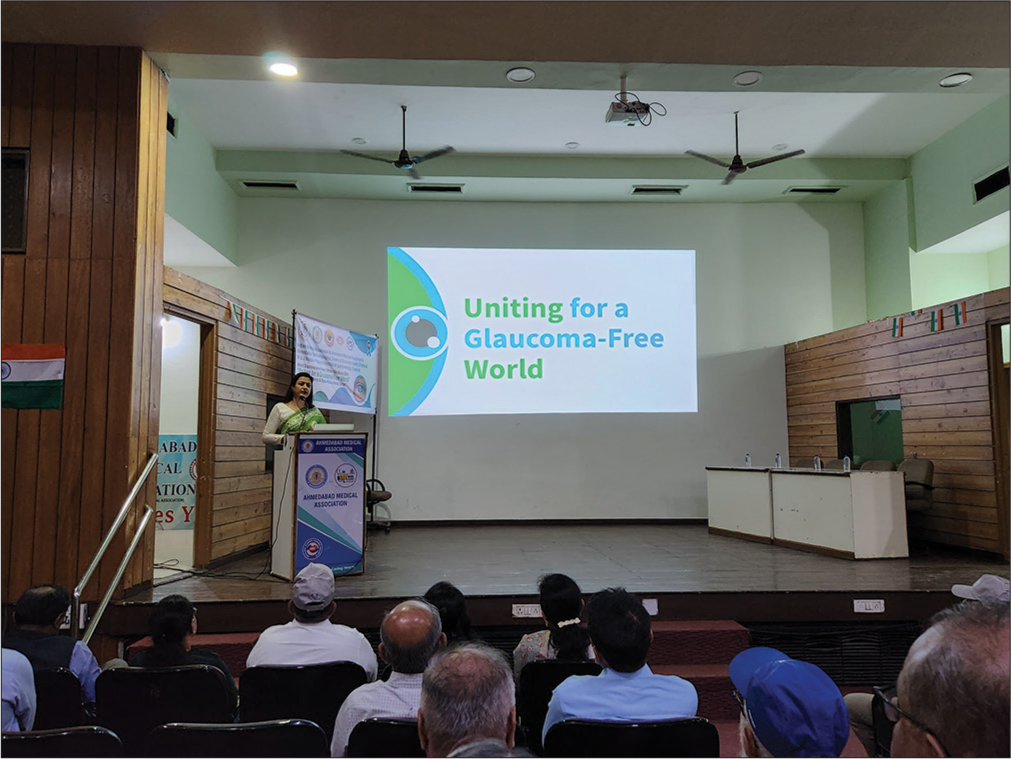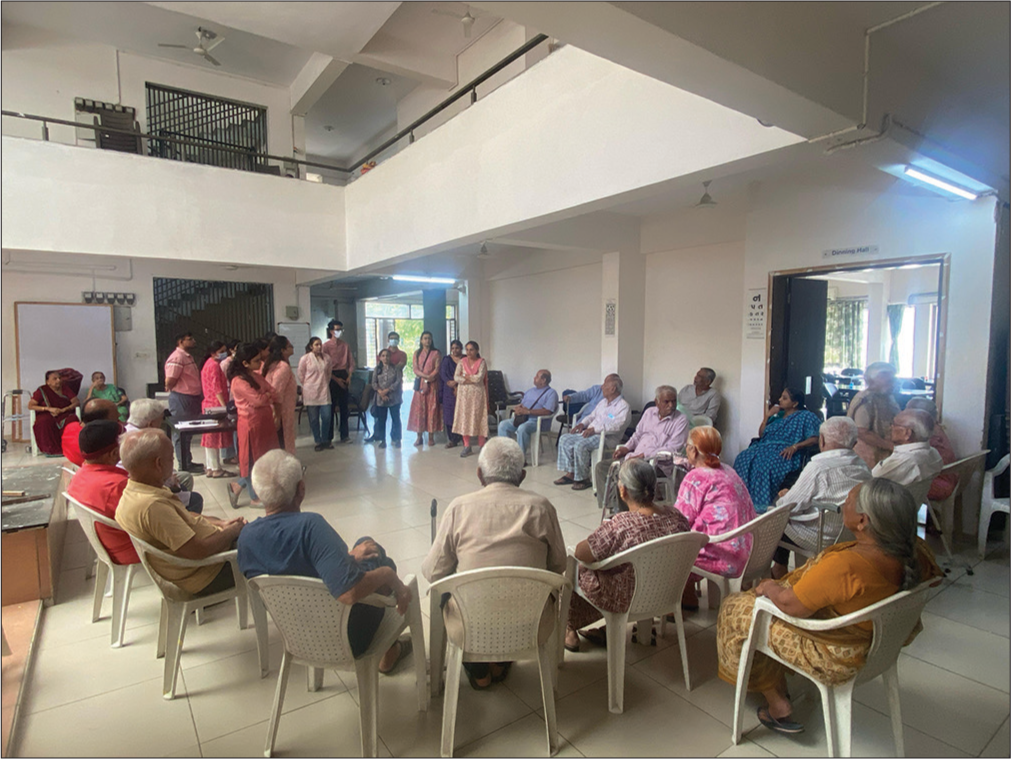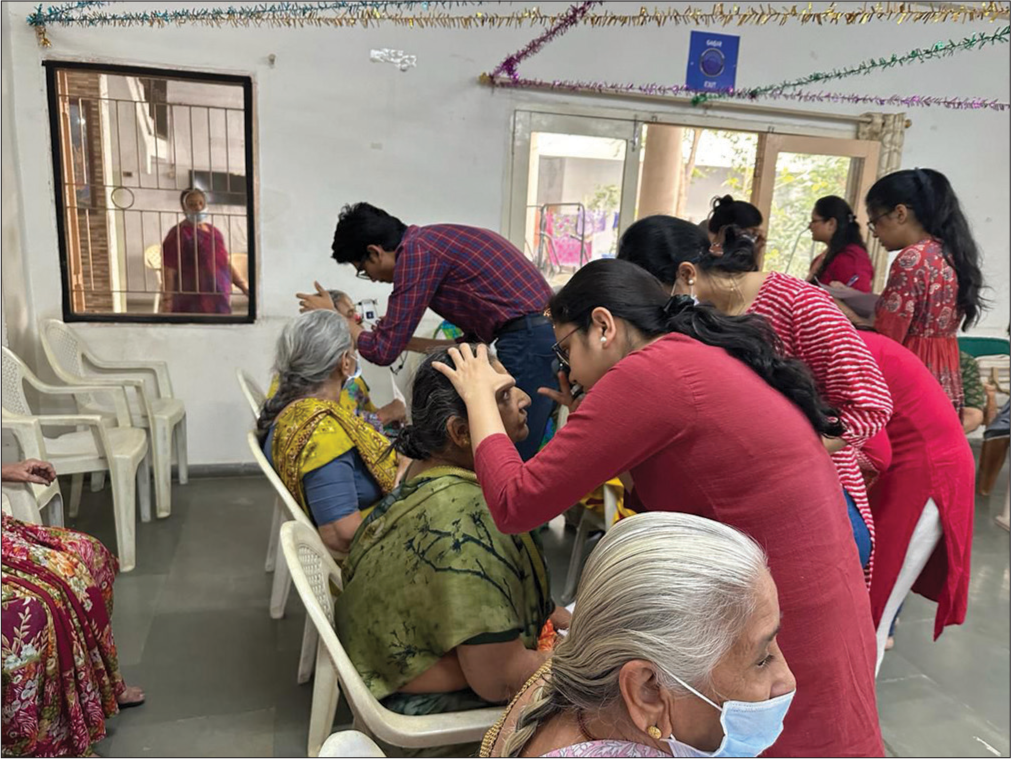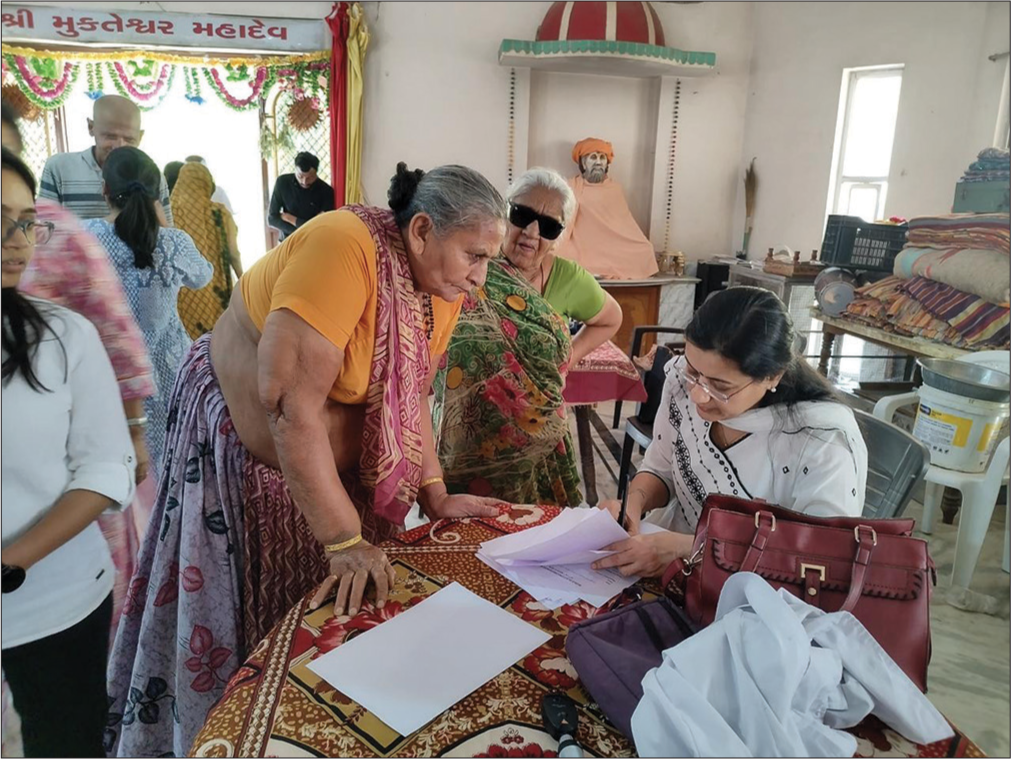Translate this page into:
Opportunistic screening – The key to prevent glaucoma-related blindness
*Corresponding author: Sanath Rajesh Khobragade, Department of Ophthalmology, M&J Western Regional Institute of Ophthalmology, Ahmedabad, Gujarat, India. sanathrajesh05@gmail.com
-
Received: ,
Accepted: ,
How to cite this article: Bhagat PR, Prajapati KM, Chauhan A, Khobragade SR, Mistry AV, Quraishi RM. Opportunistic screening – The key to prevent glaucoma-related blindness. Glob J Cataract Surg Res Ophthalmol. doi: 10.25259/GJCSRO_32_2024
Abstract
Objectives:
Glaucoma is characterised by progressive optic neuropathy and irreversible blindness. Patients with glaucoma usually seek advice only in the advanced stages due to its asymptomatic nature. Hence, it is of utmost importance to diagnose the disease early and conduct screening and awareness programmes, especially for the population at higher risk.
Materials and Methods:
This was a cross-sectional community-based study carried out in various old age homes and senior citizen clubs in a metro city of Western India during World Glaucoma Week 2024. Glaucoma screening was performed, and awareness and counselling sessions were conducted for these senior citizens.
Results:
Out of 205 senior citizens screened, 64 were referred for a detailed glaucoma evaluation and 59 for cataract and retina assessment. Only 22 persons sought consultation, of which six were found to be glaucoma suspects, two had primary open-angle glaucoma, one had secondary open-angle glaucoma, and one was a post-trabeculectomy patient with absence of follow-up. All these citizens were managed and counselled appropriately with an emphasis on compliance and lifelong monitoring.
Conclusion:
Despite glaucoma being the second leading cause of irreversible blindness worldwide, awareness is lacking among the general population. The elderly age group, although at a higher risk, is usually unaware of the need for screening and follow-up and sometimes also does not have the necessary resources or assistance. Opportunistic screening and education about glaucoma are the key factors which can help in early detection of the disease and prevention of blindness.
Keywords
Opportunistic screening
Glaucoma
Awareness
Preventable blindness
INTRODUCTION
Glaucoma is a heterogeneous group of disorders characterised by chronic, progressive optic neuropathy resulting in characteristic optic disc changes and visual field changes, associated frequently, but not always, with elevated intraocular pressure (IOP).[1,2] Globally, it is the second most common cause of blindness and approximately 11.9 million people are affected by glaucoma in India.[3,4] Glaucoma is often detected incidentally when a patient visits an ophthalmologist for other reasons. Furthermore, the majority of the patients usually remain asymptomatic till the end stage, when they are diagnosed with significant and irreversible vision loss. Worldwide, about 50% of glaucoma patients in the community remain undiagnosed, and in India, this number is as high as 90%.[5] Lack of awareness about the disease leads to blindness, which can be prevented by early screening and education of the population. Since population screening is a difficult and herculean task, under-detection and late diagnosis are the major causes of glaucoma-related visual impairment, cost-effective opportunistic glaucoma screening can be an effective measure for the early identification and prevention of glaucoma.[6] World Glaucoma Week (WGW), an initiative of the World Glaucoma Association, is celebrated globally every year, in the week around March 12, with an aim to increase awareness about glaucoma and conduct screening activities among the community for the early diagnosis of this blinding disease. This year, during WGW (10–16 March 2024), we conducted awareness sessions along with glaucoma screening camps for various senior citizen communities, one of the high-risk populations for glaucoma, so that they could be further investigated for final diagnosis, early treatment could be instituted as necessary, and follow-up and monitoring could be emphasised. This article is a further attempt to spread awareness about the disease and emphasise the need for such screening and awareness activities among the high-risk population.
MATERIALS AND METHODS
Approval to conduct this study was obtained from our Institutional Ethics Committee; this was a cross-sectional community-based study conducted by three faculties and 11 ophthalmology postgraduate trainees of the department of glaucoma at our tertiary care centre in western India during the WGW 2024 (10–16th March 2024) [Figure 1]. We visited four old age homes and one senior citizen club in our city to conduct a glaucoma screening and awareness programme for the senior citizens. The senior citizens were informed and educated about the tests and then screened throughout the week. A total of 205 senior citizens were screened after taking informed consent that the data gathered from this event could be used for academic and research purposes. Personal and demographic details of the senior citizens were noted, along with thorough ocular and systemic history [Figure 2]; this was followed by an ophthalmic workup that included visual acuity using Snellen’s chart, IOP measurement using portable rebound tonometer (iCare IC200), anterior segment evaluation using torchlight, central fundus examination using direct ophthalmoscope (Heine Beta 200) and retinal nerve fibre layer assessment using optical coherence tomography (Zeiss Cirrus 5000) wherever possible [Figure 3]. Those who were found to have glaucoma or appeared suspects were referred to our tertiary care centre for detailed evaluation and further management. All the senior citizens were made aware of the risk factors for glaucoma, and those referred for further evaluation were educated about the treatment and the need for regular follow-ups. The data gathered was entered in a Microsoft Excel sheet and analysis was done by frequency and percentage distribution.

- Introductory seminar on glaucoma awareness during World Glaucoma Week 2024.

- Glaucoma awareness and screening programme at old age home in Western India.

- The faculties and trainees performing glaucoma screening tests at old age home.
RESULTS
Two hundred and five senior citizens were screened belonging to the age group of 56–90 years. Fifty-two (25.3%) of these senior citizens were known cases of diabetes mellitus on treatment, whereas 31 (15.1%) were known cases of hypertension on treatment. Six senior citizens (2.92%) had a positive family history of glaucoma in first-degree relatives. A male predominance was noted (59%). One hundred and twenty-three (60%) senior citizens of the screened population were referred for further evaluation, of which 31% (63 senior citizens) were referred for detailed glaucoma assessment, while the rest, 59 (28%), required cataract and retina evaluation. IOP more than 21 mm of Hg was found in 2.92% (six) senior citizens. Out of the 64 senior citizens who were referred for complete glaucoma evaluation, 22 (10.56%) were brought to our institute. Out of these, 6 (2.9%) were found to be glaucoma suspects with respect to their optic disc changes, and IOP, 2 (1%) had primary open-angle glaucoma, one had secondary open-angle glaucoma, and one was a post-trabeculectomy patient with absence to follow-up. The established cases were prescribed antiglaucoma drugs and regular follow-ups. They were also advised glaucoma screening in their first degree relatives wherever possible. The suspects were advised an initial 3 monthly observations.
DISCUSSION
Glaucoma is responsible for blindness in 1.2 million people and accounts for 5.5% of total blindness, putting it as one of the leading causes of irreversible blindness in India.[7] The prevalence of glaucoma in India has been previously reported by the Central India Eye and Medical Study, Vellore Eye Study, Andhra Pradesh Eye Disease Study, Aravind Comprehensive Eye Survey, Chennai Glaucoma Study and the West Bengal Glaucoma Study, although these have been population-based studies.[8-13] Predictive factors for the development of glaucoma in individuals may be high refractive errors, family history, older age, systemic vascular diseases, thin central corneal thickness and higher cup-to-disc ratio of the optic disc.[14-17] Thomas et al. have stated that population-based screening is inappropriate in the absence of adequate infrastructure, which includes the availability of trained ophthalmologists, time and instrumentation required to confirm the diagnosis and that case detection should be relied on.[18] In a pilot study conducted by Zhang et al., the authors emphasised the importance of identifying opportunities for glaucoma screening and educating the patients about the need for regular screening with increasing age and mentioned that opportunistic screening can be effective in detecting glaucoma.[6] The scope of opportunistic screening can be elaborated to detect glaucoma in susceptible individuals.[19,20] The critical challenges in glaucoma management in India are low levels of awareness, undetected and undiagnosed cases, poor access to glaucoma diagnostic and therapeutic services and issues related to compliance with treatment,[21] which can be overcome through opportunistic screening in at-risk subjects at every eye health-care system. The asymptomatic nature of the early stages of the disease is also a major reason for missing the diagnosis, which necessitates screening. Even employees of healthcare setup themselves are unaware of the need for screening in spite of having a family history.[22] The elderly population, who are at a higher risk for glaucoma, face some additional challenges, such as the presence of other ocular comorbidities which may interfere with the diagnosis and management, lack of motivation for screening and follow-ups, compliance issues, mobility issues, dependence on others for travel and treatment, financial constraints, etc. A global initiative was taken up a decade ago by the World Glaucoma Association to increase awareness about glaucoma in the community and promote more screening programmes in the form of the WGW, which is the week around 12 March.[23] Various activities such as awareness walks and talks, video presentations, poster displays, media news and screening activities, all directed toward the spread of glaucoma awareness among the general population, are encouraged throughout the world during this week. Our screening programme was also carried out as a part of this WGW activity. The limitation of our study was that not all of the screened elderly population that was advised for complete glaucoma evaluation could be subjected to further workup, which could be attributed to lack of motivation, lack of support and lack of transport facilities made available for them and or physical debility. Nevertheless, this study helps to emphasise the need for more opportunistic screening and awareness sessions, especially in the high-risk population [Figure 4].

- Counselling for regular ophthalmic evaluation and follow-up.
CONCLUSION
Despite glaucoma being the second leading cause of irreversible blindness worldwide, awareness is lacking among the general population. The elderly age group, although at a higher risk, is usually unaware of the need for screening and follow up and sometimes also do not have the necessary resources or assistance. Opportunistic screening and education about glaucoma are the key factors which can help in early detection of the disease and prevention of blindness.
Ethical approval
The research/study approved by the Institutional Ethics Committee at BJ Medical College and Civil Hospital, Ahmedabad, number-EC/Approval/46/2024/19/04/2024, dated- 19/04/2024.
Declaration of patient consent
The authors certify that they have obtained all appropriate patient consent.
Conflicts of interest
Dr. Purvi Raj Bhagat and Dr. Kamini Prajapati are on the Editorial Board of the Journal.
Use of artificial intelligence (AI)-assisted technology for manuscript preparation
The authors confirm that there was no use of artificial intelligence (AI)-assisted technology for assisting in the writing or editing of the manuscript and no images were manipulated using AI.
Financial support and sponsorship
Nil.
References
- The early history of glaucoma: The glaucous eye (800 BC to 1050 AD) Clin Ophthalmol. 2015;9:207-15.
- [CrossRef] [PubMed] [Google Scholar]
- Becker-Shaffer's diagnosis and therapy of the glaucomas. (1st ed). Philadelphia, PA: Mosby/Elsevier; 2009.
- [CrossRef] [Google Scholar]
- Global estimates of visual impairment. Br J Ophthalmol. 2012;96:614-8.
- [CrossRef] [PubMed] [Google Scholar]
- Glaucoma in India: Estimated burden of disease. J Glaucoma. 2010;19:391-7.
- [CrossRef] [PubMed] [Google Scholar]
- Angle-closure glaucoma in an urban population in southern India: The Andhra Pradesh eye disease study. Ophthalmology. 2000;107:1710-6.
- [CrossRef] [Google Scholar]
- Integrating opportunistic glaucoma screening into general health examinations in China: A pilot study. Clin Exp Ophthalmol. 2019;47:1000-8.
- [CrossRef] [PubMed] [Google Scholar]
- National blindness and visual impairment survey India 2015-2019. A summary report. Available from: https://npcbvi.gov.in/writereaddata/mainlinkfile/file341.pdf [Last accessed on 2024 May 24]
- [Google Scholar]
- Prevalence and associated factors of glaucoma in rural central India. The central India eye and medical study. PLoS One. 2013;8:e76434.
- [CrossRef] [PubMed] [Google Scholar]
- Prevalence of primary glaucoma in an urban South Indian population. Indian J Ophthalmol. 1998;46:81-6.
- [Google Scholar]
- Open-angle glaucoma in an urban population in Southern India: The Andhra Pradesh eye disease study. Ophthalmology. 2000;107:1702-9.
- [CrossRef] [PubMed] [Google Scholar]
- Glaucoma in a rural population of Southern India: The Aravind comprehensive eye survey. Ophthalmology. 2003;110:1484-90.
- [CrossRef] [PubMed] [Google Scholar]
- Prevalence of open-angle glaucoma in a rural South Indian population. Invest Ophthalmol Vis Sci. 2005;46:4461-7.
- [CrossRef] [PubMed] [Google Scholar]
- A population based survey of the prevalence and types of glaucoma in rural West Bengal: The West Bengal glaucoma study. Br J Ophthalmol. 2005;89:1559-64.
- [CrossRef] [PubMed] [Google Scholar]
- Importance of population-based studies in clinical practice. Indian J Ophthalmol. 2011;59(Suppl 1):S11-8.
- [CrossRef] [PubMed] [Google Scholar]
- Prevalence of glaucoma in Eastern India: The Hooghly river glaucoma study. Indian J Ophthalmol. 2016;64:578-83.
- [CrossRef] [PubMed] [Google Scholar]
- Prevalence and risk factors for primary glaucomas in adult urban and rural populations in the Andhra Pradesh Eye disease study. Ophthalmology. 2010;117:1352-9.
- [CrossRef] [PubMed] [Google Scholar]
- Risk factors for glaucoma onset and progression. Surv Ophthalmol. 2008;53(Suppl 1):S3-10.
- [CrossRef] [PubMed] [Google Scholar]
- Population-based screening versus case detection. Indian J Ophthalmol. 2002;50:233-7.
- [Google Scholar]
- Opportunistic eye screening among first-degree relatives of glaucoma patients at a suburban tertiary center in Malaysia. Cureus. 2022;14:e25772.
- [CrossRef] [PubMed] [Google Scholar]
- Screening of accompanying first degree relatives of patients with primary open angle glaucoma. Nepal J Ophthalmol. 2022;14:4-9.
- [CrossRef] [PubMed] [Google Scholar]
- Towards better management of glaucoma in India. Indian J Ophthalmol. 2023;71:686-8.
- [CrossRef] [PubMed] [Google Scholar]
- Glaucoma screening of employees of a tertiary eye care center. Indian J Community Ophthalmol. 2021;1:37-40.
- [Google Scholar]
- First world glaucoma day, March 6, 2008: Tackling glaucoma challenges in India. Indian J Ophthalmol. 2008;56:97-8.
- [CrossRef] [PubMed] [Google Scholar]







